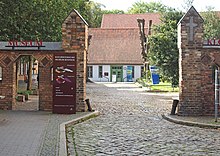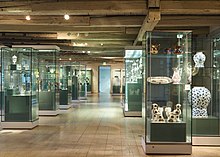Rostock Cultural History Museum
The cultural history museum , initially the Rostock Municipal Art and Antiquity Museum , is one of the largest and most important museums in Mecklenburg-Western Pomerania . It was founded in 1859.
history
The foundation of a historical museum in Rostock goes back to the year 1859. In 1841 citizens gathered in the art association of the city of Rostock to collect art objects from the city of Rostock and to present them in a museum. In 1858, a building in Steinstrasse was bought with the support of the Sparkasse. The rapidly growing collections were first presented to the public in 1885 in the Lindenhof on Lindenstrasse. As this building soon became too small for the exhibition, the Society's building, which still exists today, was bought by the city in 1901 and converted into a museum. The Art and Antiquity Museum was officially opened on October 4, 1903. After the museum was reorganized as a municipal museum in 1936, the holdings of the ethnological collection were also incorporated into the museum. During the war, the stocks were relocated to safes and also to the village churches of Belitz and Kavelstorf , the mansions in Tessenow, Niekrenz and Plüschow and the Erdmannsdorff and Carolath castles, which resulted in considerable losses in the collections. After 1945 the collections were returned to the restored building at the Steintor. On May 1, 1946, the Rostock City Museum was able to reopen. After the decision had been made to use the building at the Steintor as a shipping museum, the collections were temporarily housed in the Kröpeliner Tor .
The idea of using the Monastery of the Holy Cross as a museum location dates back to the time the monastery was dissolved in 1920. It was not until 1976 that the city council of Rostock decided to gradually reconstruct and convert it into a museum. The first construction phase was handed over in 1980 on the occasion of the 18th GDR Workers' Festival in Rostock. The second construction phase followed in 1984. However, further plans were not taken into account, the renovation of the monastery remained incomplete for the time being, probably due to a lack of money. Planning could only be resumed after reunification in 1989. The restoration of the west wing was started in 1997. After the renovation of the monastery was completed, the associated monastery church was also restored and can be viewed by museum visitors.
Collections (selection)
Among other things, the Museum of Cultural History houses the largest German collection on Prince Blücher von Wahlstatt . With its extensive collection of art and cultural-historical objects, the museum is one of the most important documentation sites in Mecklenburg-Western Pomerania. In addition to its art collection, it houses an extensive inventory of unique documents of urban life and the economy from eight centuries in Rostock. Special exhibitions on various topics are shown regularly.
Paintings and graphics
The museum houses a collection of around 70 paintings of Dutch painting from the 16th to 19th centuries, which are among the most important in northern Germany. It contains works by important artists such as Jan Bruegel the Elder. J. , Ludolf Bakhuizen , Melchior de Hondecoeter or Salomon van Ruysdael and is complemented by many graphics, including by Rembrandt van Rijn . Most of them are gifts or legacies from the end of the 19th century. In World War II, some went from the stock lost. In the 1950s, important pieces could be acquired through purchase. Mainly history , landscape , still life and genre paintings are shown , which give an insight into the development of the golden age of painting in the Netherlands.
- Dutch painting
Jan Brueghel : River Landscape
Ludolf Backhuysen : Ships on the Sea
Melchior de Hondecoeter : Poultry
Salomon van Ruysdael : River Landscape
David Teniers : In the tavern
Rembrandt van Rijn : Landscape with a Carriage on the Road
Rostock city views
The Rostock city views provide a glimpse into the city's past and the changes in the cityscape from the early 19th to the 20th century. The paintings by the artists, including by Georg Friedrich Kersting , give an impression of the panorama of the city on the Warnow , which is characterized by four large churches.
- Rostock city views
GF Kersting : View of Rostock from the west
Paul Tischbein : View of Rostock from the Spittaschen garden house
Modern
- Bernhard A. Böhmer Collection (Ostracized Modernism)

With the holdings of the art dealer and Barlach friend Bernhard A. Böhmer, the museum has a collection of “degenerate art” . It is the last preserved bundle of the National Socialists from 1937. A part of the works confiscated in the “Third Reich” is shown and information is provided about the facts of the cultural policy of the time.
- 20th century paintings
The collections include paintings by Lovis Corinth , Erich Heckel , Oskar Schlemmer , Alexej von Jawlensky , Christian Rohlfs and several artists from the Schwaan artist colony , including Franz Bunke and Rudolf Bartels .
- 20th century sculptures
Some sculptures are exhibited by Ernst Barlach , who worked for 28 years in Güstrow , the district town of the Rostock district , and who died here in Rostock in October 1938 from a heart attack. Furthermore, sculptures by Wilhelm Lehmbruck and Gerhard Marcks can be seen.
- Barlach sculptures
Sleeping Peasant Couple (1912), Böttger stoneware
Sacred art
In the historical refectory , built around 1480, numerous medieval sacred works of art and furnishings are on display. In the Middle Ages Rostock had four large parish churches, five monasteries, two hospitals and some chapels. In the first half of the 19th century, all but one of the monastery and hospital churches in Rostock were demolished. Many objects were lost during renovation work on the parish churches around 1900. Until then there were still 182 main and side altars. The collection shows pieces that have been preserved, some of which come from the no longer existing churches and monasteries in the city of Rostock. Many medieval works of art have been preserved in particular from the Dominican monastery church of the Johanniskloster . In addition, part of the treasure of the “Monastery of the Holy Cross” is exhibited, as well as altars, small works of art and church stalls from the parish church of St. Nikolai and the other former monasteries of the Dominican monks and Cistercian nuns .
- Sacred art
Handicrafts
This collection includes around 35,000 objects from the 16th to the early 20th centuries. It shows works made of pewter, silver, ceramics, as well as clocks and historical jewelry, and provides information on the development of old handicrafts. The exhibition gives an insight into the life of the middle and upper classes of the city of Rostock and of the masterful work of the craftsmen of the time. For example clocks from the Empire period (around 1800). Portal clocks made of ebony and alabaster , made in Vienna , a center of clock production at that time. For more than 100 years, the individual, mostly valuable exhibits were collected by the citizens of Rostock. They are presented in a room in which some old ceilings and wall paintings from the monastery era can still be seen.
- Handicrafts
Welcome cups of individual offices and companies
toy
Trains , steam engines , dolls and dollhouses , construction sets , children's games and many other utensils from the past two centuries can be seen. These are almost exclusively toys made by wealthy citizens, as the toys, some of which are made from rags, sticks or shards, have hardly been passed down to the poorer population today. For this reason, only part of everyday gaming life from the period between 1850 and 1950 can be shown here. The historical toy also includes the anchor stone construction kit invented by the brothers Gustav Lilienthal and the aviation pioneer Otto Lilienthal .
- toy
Coins
This collection focuses on the holdings of the Rostock and Mecklenburg Mints. They offer an overview of the history of coins and money from their beginnings to the 19th century. The focus is on silver money from the Hanseatic era of the 14th and 15th centuries, silver shillings from the 15th to 16th centuries and thalers and gulden from the late 16th to the 18th century.
Web links
- Literature on the Rostock Cultural History Museum in the State Bibliography MV
- Ostsee.de: Rostock Cultural History Museum
Individual evidence
- ^ Website of the Rostock Cultural History Museum. Retrieved January 16, 2020 .
Coordinates: 54 ° 5 '14.9 " N , 12 ° 7' 58.2" E

























